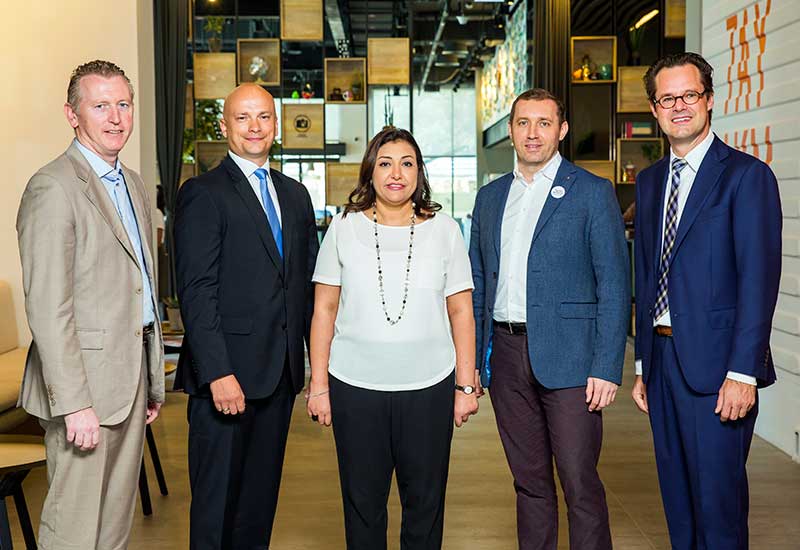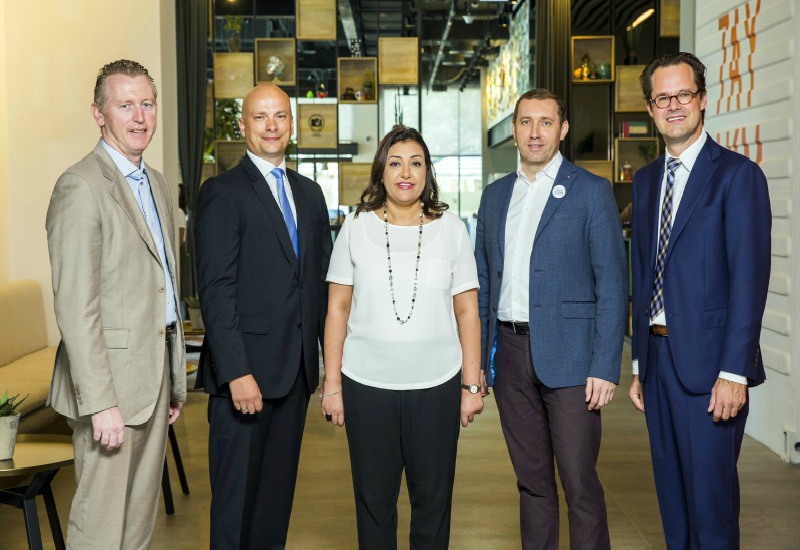 Five leaders in the Middle Easts mid-market hospitality industry convened at Rove Trade Centre, Dubai to discuss relevant issues facing the sector, helping to set the agenda for the Hotelier Express Summit 2017.
Five leaders in the Middle Easts mid-market hospitality industry convened at Rove Trade Centre, Dubai to discuss relevant issues facing the sector, helping to set the agenda for the Hotelier Express Summit 2017.
With the growth in mid-market hotel supply, how are you coping with pressure on rates?
De Graaf: The growth in the past year in RAK has been tremendous; there’s been a very strong focus on high-end resorts up to the luxury and now, the mid-scale segment with the Hilton Garden Inn and a couple of other brands following shortly within the next year and a half. The trend that you see happening in Dubai, with the rate decline, is already something that is starting to happen in Ras Al Khaimah. Where do you end up with a five-star hotel and a four-star hotel from a price perspective? I think there you might have some challenges. Although I think mid-market resorts can work but it needs to be defined clearly in which lane they are going to swim.
Bridger: In Dubai while you see a decline in rates, obviously you still see some of the best occupancies in the world. We’ve announced that we’re going into long-stay with the launch of Rove Home. We’re working on a long-stay concept and potentially we think this has the ability to go into different segments. Again within the next six to 12 months, we’ll probably be announcing a next generation Rove. We think Dubai has a big market for long-stay, lifestyle, affordable accommodation.
De Graaf: Overall, the ADR is a challenge for low seasons like what we have right now in the summer, it’s more challenging. The gap between mid-scale, upscale, upper upscale and even up to luxury is shrinking. A lot of the luxury and upscale are not swimming in their lanes and that puts a lot of pressure on us – the mid-scale.
Mahgoub: This is definitely happening especially in areas like Barsha where you have the upscale, five-star hotels pricing themselves like a four-star hotel. With many rooms available, customers can pick where they want. There is pressure for us mid-scale operators. Especially when you consider the number of hotels opening in the area and the rates that they are offering.
De Graaf: In the last few years where you see multiple brands coming into a destination, the focus from a regional office is destination marketing or destination positioning. So we really need to make sure that our hotels are positioned in the right way as well. Otherwise you will end up with a Waldorf competing with a Hilton Garden Inn. At the end of the day, that should never be the case because they have their own brand identities. So pricing should be purely done on a positioning perspective as well as a marketing perspective.
Siegfried Poppe: Yes, pricing is normally done against comp set.
Bridger: At Emaar, we’ve got well defined brands so we don’t really experience that price pressure. I think you stick to your brand and you stick to your positioning and pricing strategy.
Poppe: I think if you look at citywide numbers of ADRs, you need to look at it in two ways: one is that the additional supply which comes to market, there is a lot of mid-scale. So if you take the total ADR of the city, and you have more mid-scale in the city, the overall ADR in the city will drop because there’s more production of a lower-rated segment. That’s part of it. And then for sure, you have the traditional opening rates trend. Which affect the market because obviously if you’re an established property and you haven’t renovated the past five years, you will suffer from it because you need to go after these customers. But I think established products with solid offerings have enough to hold their rates. There is no need for a catastrophic image. We just said, Dubai has one of the highest occupancies in the world, highest ADRs in the world, so it’s still a very strong performing city. It was the wish of the government for the city to have a lower rate so it becomes more affordable and stable in the right way because it drives more business from various segments and travellers. It’s more sustainable for the city – otherwise you are all milking from the same cow. I think it’s very healthy that other mid-scale brands are entering the market. We’ve even got new supply coming from entry level hospitality models and I think it just completes the image for Dubai as it moves towards maturity.
Guminski: It makes Dubai more affordable. Instead of being just a luxury destination, Dubai can now be for everybody, with budget airlines, mid-scale hotels. It’s also the demand. People that couldn’t afford the destination before, now they are coming to town.
Poppe: On the flip side, there are also changes in the way we operate, changes in the way authorities are looking at us. I think there are a couple of consequences coming into the landscape where you cannot operate anymore a traditional model of a five-star luxury structure. How are the regulatory authorities looking at the new supply that’s coming? The customer trends are changing – how are they adapting? The authorities in Dubai are very attentive to the market; they look at changes and they act on it, for example, opening up specific source markets, bringing more business to the destination. So I think it will also be interesting to hear their part.

| Advertisement |










 Search our database of more than 2,700 industry companies
Search our database of more than 2,700 industry companies









